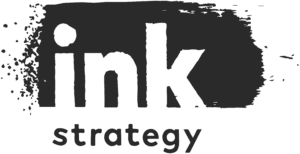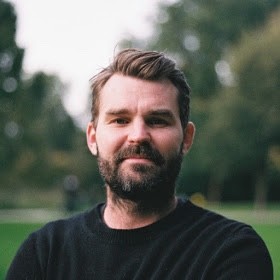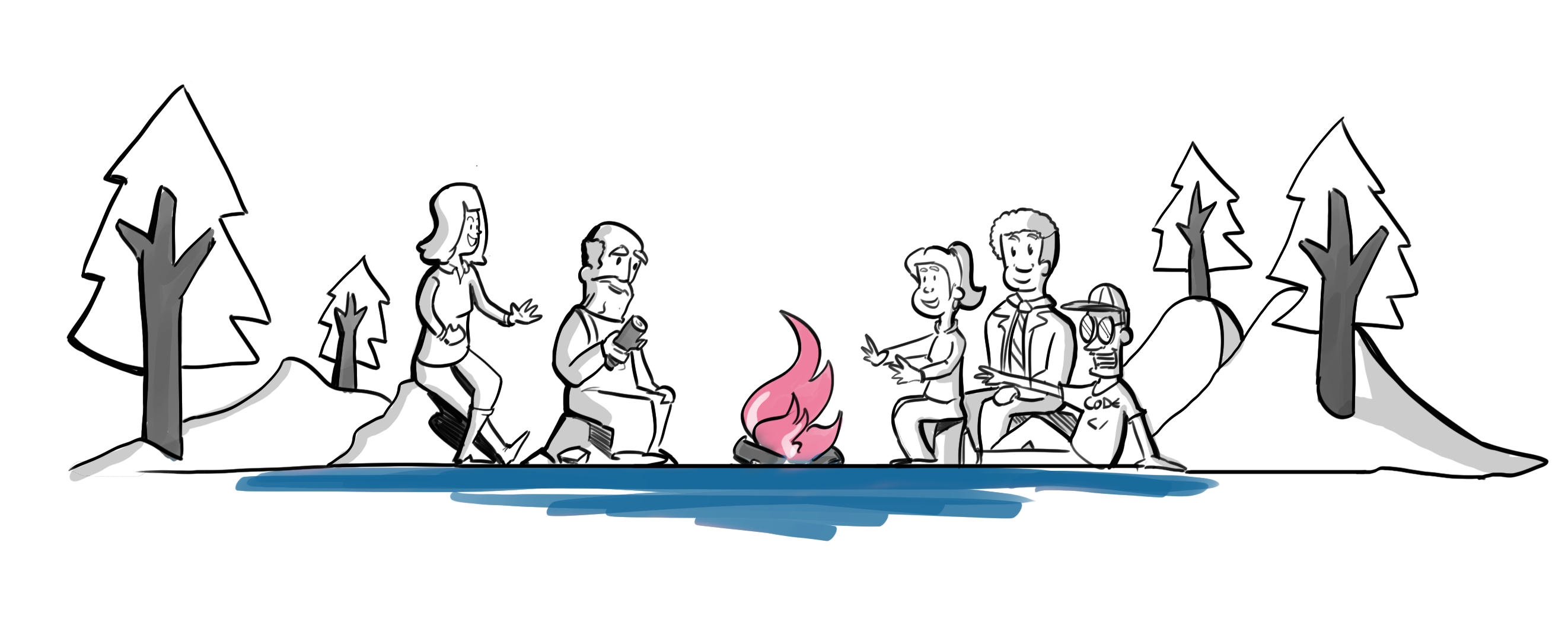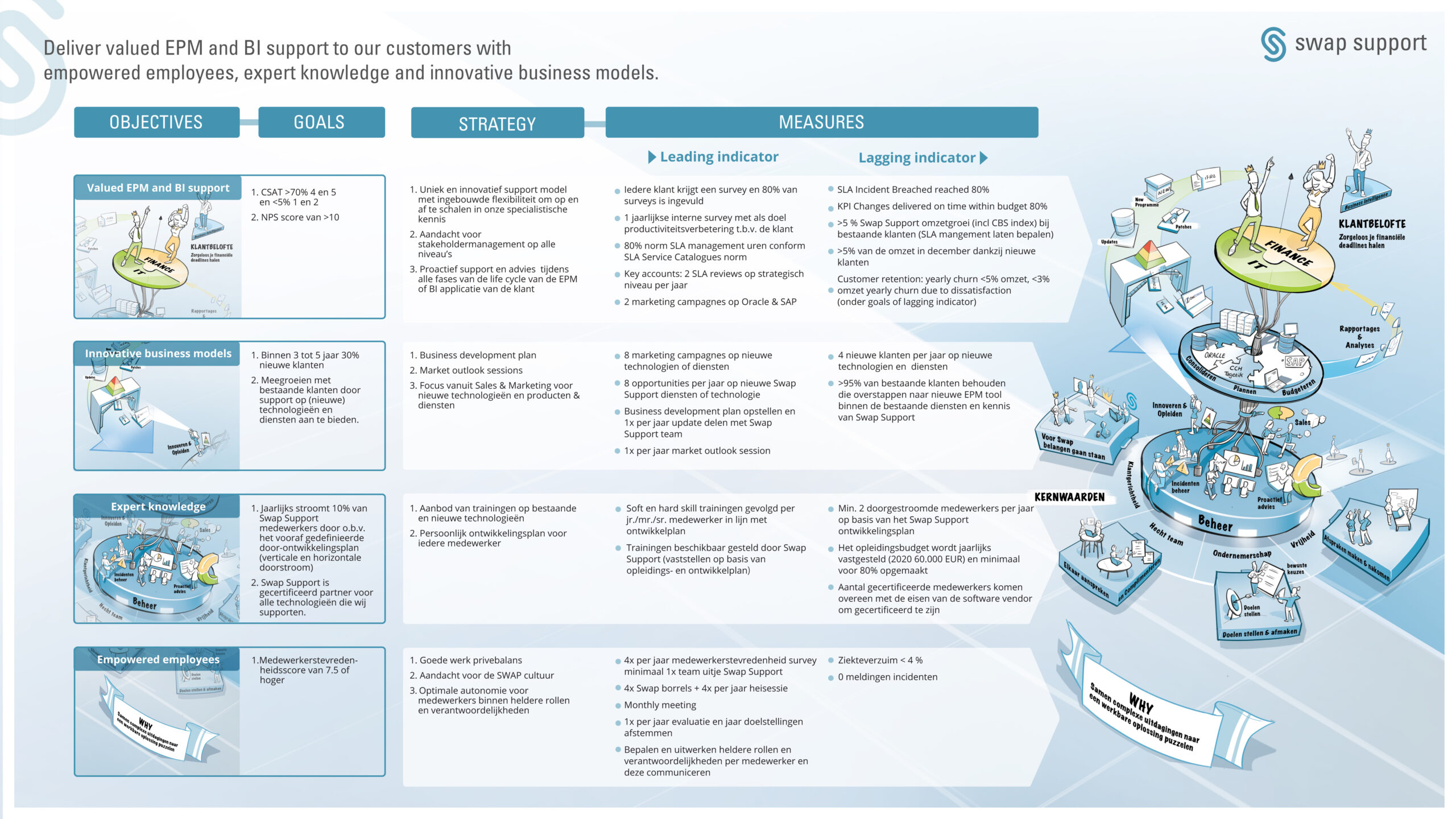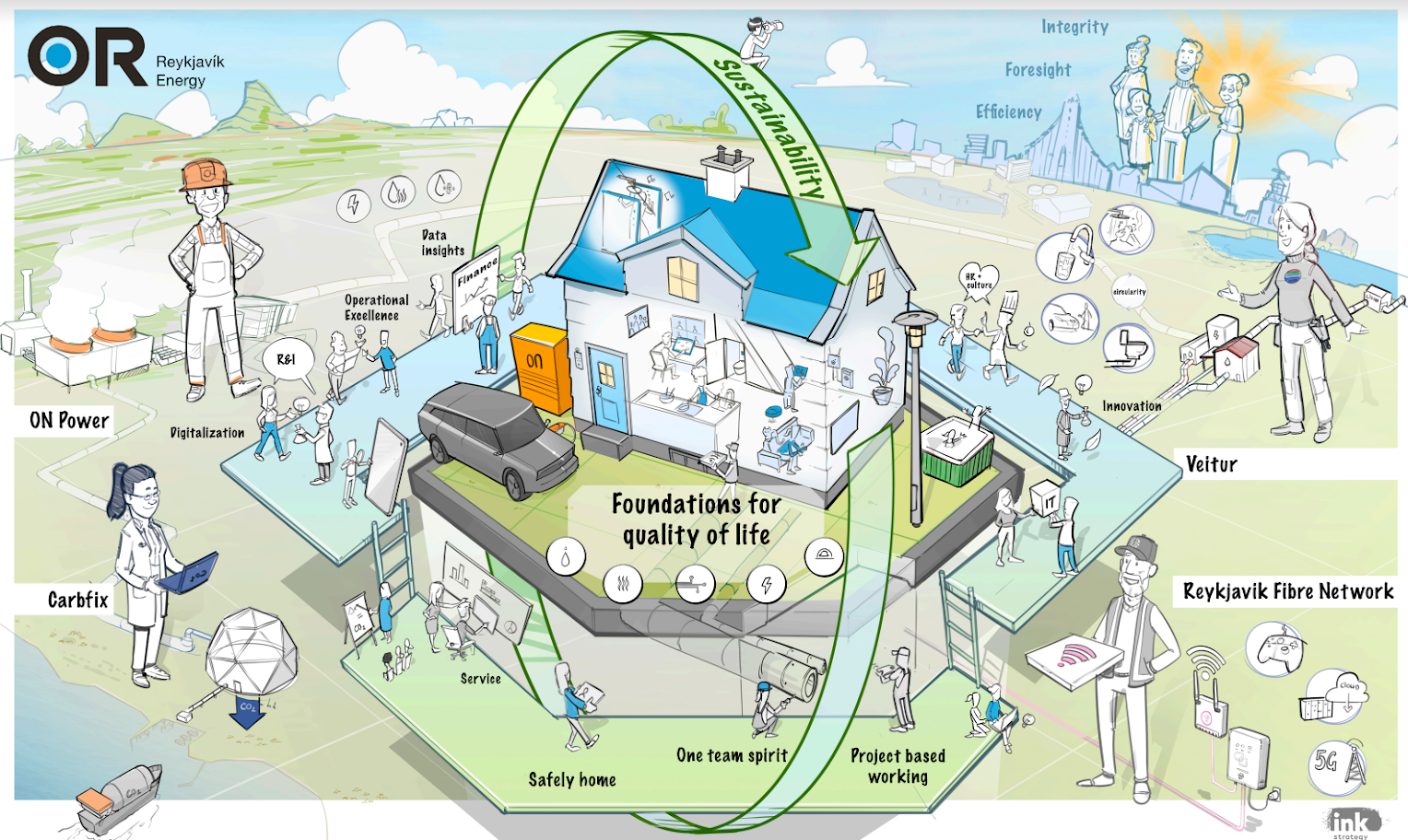Everything you need to know about storytelling to make your story stick.
The Kotter model is an 8-step model for change management and how to approach using this model correctly.
Although the Kotter model has all the ingredients to make change successful and provides an excellent model, at Ink Strategy, we believe in a more human-centered approach.
In this article, we’ll take an in-depth look at the Kotter model, how you can utilize it to move your organization towards a clear vision, and how the principles of human-centered design come into play.
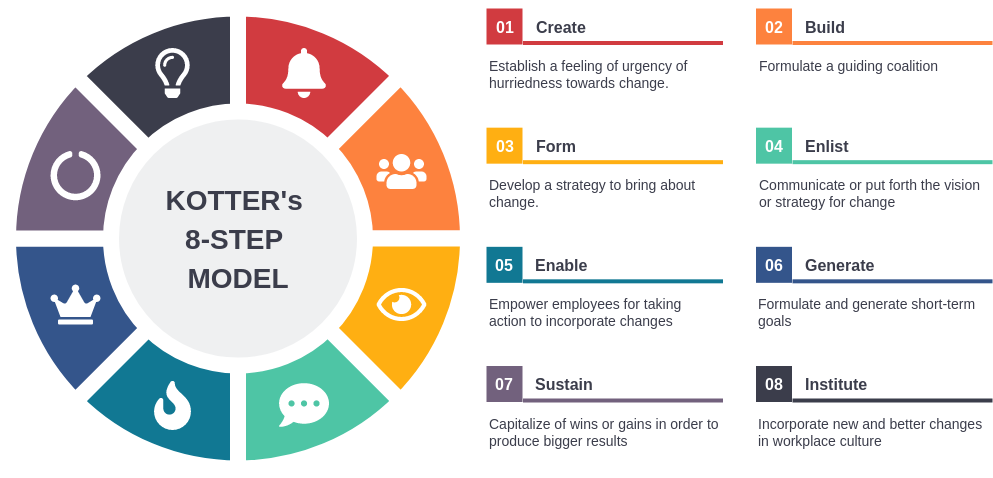
The history of the Kotter model
The Kotter model was introduced by John Kotter, Harvard Business School Professor and renowned change expert. His model for managing change was developed by researching a hundred organizations that went through change, for over four decades.
His research paid off. John was able to identify the common success factors and documented them in his bestselling book Leading Change. The 8-step model is now used across all industries and has helped hundreds of organizations worldwide to successfully implement change.
The 8 steps in the Kotter model for change management
When implementing change, there are many obstacles to overcome. Fear of the unknown, lack of teamwork, frustration. All these obstacles need to be heard and overcome in order to move on from them.
By following the 8 steps in the Kotter model, these challenges can be overcome and won’t stand in the way of successfully implementing change.
The benefits and challenges of the Kotter model
The Kotter model is a proven model to guide and institute change. Its main benefits and challenges in applying the mode are.
The benefits of the Kotter model
It’s a simple 8-step process that’s easy to understand and logical in it’s top down implementation.
Focus on bringing everyone on board with the same vision and strategy.
A proven process tested on hundreds of organizations worldwide.
The challenges of the Kotter model
It’s a top-down model which can cause team members to feel excluded in the earlier steps of the process.
You have to follow all the steps in the laid out sequence, or it won’t work.
If employees are not guided well or informed well enough, they may get stressed or frustrated.
Step 1: Create a sense of urgency
You can’t implement change successfully if the people within the organization aren’t aware of the urgency. By developing a sense of urgency and identifying what is holding the organization back from changing, it will lead to a clear image of the changes that need to be implemented. This sparks an intrinsic motivation to do something about it.
By starting an open conversation about factors necessary for confronting behaviour and understand the underlying motivations and beliefs, employees can understand the reasons for change.
By openly discussing the existing challenges, you create a deep analysis of the existing challenges and are able to gather valuable input.
Once your team understands the reasons why change is needed, they will also be more open to listen to the changes that you proposed.
Step 2: Form Guiding Coalitions
Managing change just won’t cut it. Guiding change takes a leadership team that is ready to show exemplary behavior working as a team to roll out a new vision.
Thankfully, you’ll find that many of these leaders working within your company already. These are the people who understand that change is needed and are willing to step forward to do what’s necessary to make sure that it’s implemented within the organization. By bringing these leaders together, you can form powerful guiding coalitions.
Naturally, the size of guiding coalitions varies based on the size of your organization and the exact changes that need to be put into place. According to Kotter, a guiding coalition should include these parts of the organization:
The sponsor
The sponsor is the initiator of the changes, usually a senior executive. The role of the sponsor is to support the team and provide the necessary resources to make the mission a success.
Senior guiding team (leadership)
The senior guiding team consists of leaders, selected by the sponsor, with the authority and knowledge to gather resources and make important decisions regarding the change. They develop the vision and roadmap for change, provide the necessary resources, assist in overcoming obstacles, resolve conflicts and communicate about the change initiative with stakeholders.
Field guiding team
The field guiding team is made up of employees who are valued and respected within the organization. They represent a large group of employees and communicate the vision for change with them and guide them through the change process.
Change teams
Change teams are groups of managers and supervisors. They are all about making sure that the tasks needed to change are finished within the deadline.

Step 3: Develop a vision and strategy
The change initiative was started because you felt that things had and should be done differently. Making your vision crystal clear is essential if you want to take your team along the path of change.
But just a vision is not enough. You also need a solid strategy, a roadmap to help the team achieve their goals. When implemented correctly, the vision and strategy bridge the gap between the current situation and make it clear where the organization will be once the changes have been made.
Step 4: Share the vision
Once you’ve put in the work to make your vision and strategy for change crystal clear, it’s time to share that vision with the team. Keep in mind that your team will be busy. They already have challenges to deal with, so it’s not enough to just send them some documents with your vision.
Sparking change is difficult, the vision has to be carried and to become part of the organization. To get people on board, you need to show leadership and share your vision clear and often.
- Hold special meetings to communicate your vision with your team and share the visuals you’ve made to make your vision easily understandable.
- Communicate the vision at every chance possible and let other leaders to the same.
- Clearly demonstrate the before and after state of your organization.
Example case
At Ink Strategy we often help organizations work on creating a compelling vision of the future dot on the horizon. Asking questions that help create alignment on the vision, mission and strategic bold steps that need to be taken.

In one busines case at AS Waton, our team worked to help improve their client experience through a bold and innovative change in strategy. Watson needed to get the technology team on board and find a way to share complex information with the rest of the organization. If they could not bridge the gap between IT and business, their inspirational vision for growth could fail.
Ink Strategy ran a series of intensive workshops. We worked with a multi-disciplinary team of leaders to create a strong visual to represent the planned redesign of the technology landscape. This was shared with IT and other teams to see if it made sense. Facilitated discussions led to a co-created compelling story to share throughout the organization. People became so connected, engaged and aligned with the new strategy that it energized them to move forward and run with the vision.
Step 5: Remove hurdles
There is no such thing as frictionless change. You can expect some hurdles along the road, some bigger than others. You’ve shared your vision and put in a lot of effort to get everyone on board with the change initiative. However, some resistance is to be expected.
By identifying the various levels of your organization and the challenges you may have to overcome at each level, you’re more able to anticipate on removing potential hurdles.
It is also important to identify the employees who are most resistant to the changes. Why are they concerned about the proposed changes? Do they understand the vision? What are their fears?
Lastly, don’t forget to identify those that have taken the lead and moved towards your vision with great determination. They see the better future that you want to create and deserve to be rewarded for taking action to making it happen.
Step 6: Celebrate small accomplishments
After successfully initiating the change, it’s important to build momentum and celebrate those small achievements along the road to stay motivated.

Collect data that demonstrates these little successes and share them widely. They deserve to be celebrated. Implementing change is difficult and because it’s not done overnight, your team may have a hard time to see the impact of small day-to-day improvements. But all these small steps add up.
- Break up a large project in multiple short projects that can easily be finished, with little room for failure.
- Reward those who contributed towards meeting the targets.
Step 7: Sustain the momentum
You’ve built momentum, you have almost everyone on board with your vision, you’re all working hard towards implementing the necessary changes and celebrating the short wins on the road.
It may seem like it’s all downhill from here, but according to Kotter, many change projects fail because the victory is declared before the changes have become deeply engrained in the company culture.
Celebrating small accomplishments is only the start in creating tangible sustainable change. They are the gas stations along the way where you can refuel your organization’s spirit and morale.
It’s important to research what went right at each step, but also to discover what could be improved on. If you see a redundant process, remove it. If you see an overcomplicated process, simplify it.
Keep building towards the bigger goal and analyze what went right and wrong each step along the way to keep improving.
Step 8: Solidify the changes
Once the changes have been successfully implemented, it’s important to create an organization that can sustain it.
The new organizational values must be implemented and individual processes have to be in line with the new vision. The changes have to be implemented in all day-to-day operations in order for them to stick.
To solidify the changes and make them part of the company culture, do the following:
- Communicate about the benefits of the new way of doing things.
- Implement changes in the company culture to align it with the new vision.
- Incorporate your new values and vision into your hiring policy and reward system for current employees.
- Offer training to guide employees and help them build skills that are relevant to the new situation.
- Change or remove old processes that do not align with the changes you’ve implemented.

The Kotter model needs human-centered design principles
The Kotter model is composed of excellent ingredients for successful change. However, the model dates back to a time when change could be approached from a more systematic point of view, with less attention to the human side of change.
Kotter advises creating a change-guiding coalition based on the traditional hierarchy of the organization. Back then, organizations were rarely organized like Spotify, with a flat and overlapping organizational structure. At Ink Strategy we say: ditch the silo’s and embrace creativity across the board.
Change is better and more impactful when infused with human-centered design principles. With the right approach, you can change faster and more sustainable. We look for great ideas in every corner of the organization.
The 4 principles of human-centered design
Where Kotter focuses on the hard parts of change with less emphasis on people at every stage of the transformation, Kotter’s step-by-step approach can disempower employees. For change to be implemented successfully in today’s modern age, people need to feel heard.
The principles of human-centered design are a great addition to the Kotter model, because they help us focus on empathizing with people as the starting point of change. They are:

- People centered
- Solve the right problem
- Everything is a system
- Small & simple interventions
By engaging people in the co-creation of your vision, they become part of the process and feel empowered and heard. Within human-centered design, we invite people to be part of the playful and explorative exercise.
This more people centric approach improves the Kotter model by designing change to fit the culture and the values from the start of the change.
Changing an organization is challenging, but worth it
Working to create change in your organization may be one of the toughest things you’ve ever done in your professional career. But if you follow the Kotter model, your chances at successful change are much higher. With the right preparation, patience and persistence, you can do it too.
Do you need help to activate your employees and help them to contribute to the vision of your organization? We are your partner in transformation, who help you to move towards your vision with a tailored approach.
Whether you have a specific project in mind or are just interested in exploring what a partnership could look like, contact us today. We’d love to get in touch!
Recent posts
The OGSM model is a strategic planning model that connects the dots in your strategic plan...
A bigger picture helps team collaborate, clarify ideas and empower the entire organisation...
